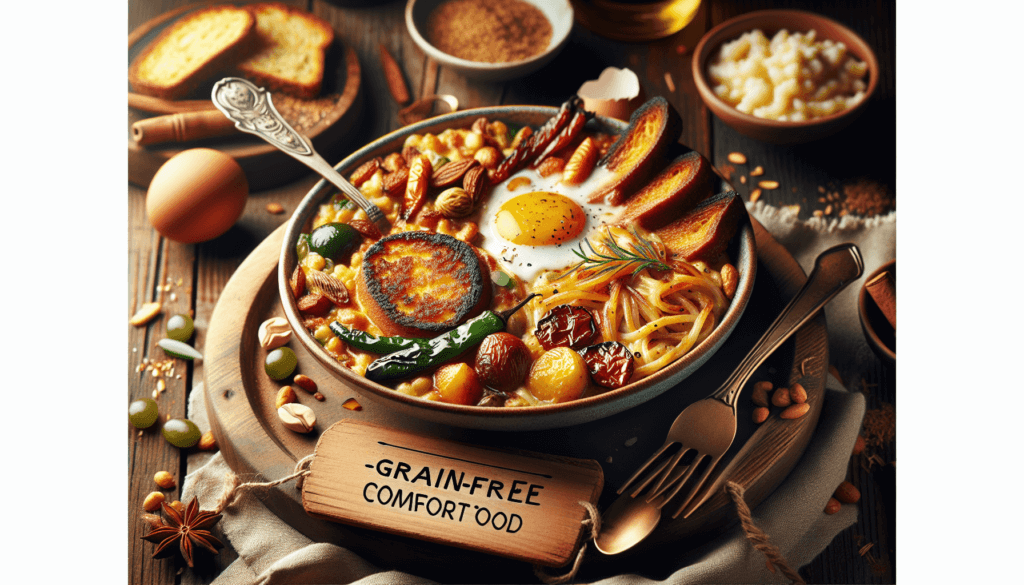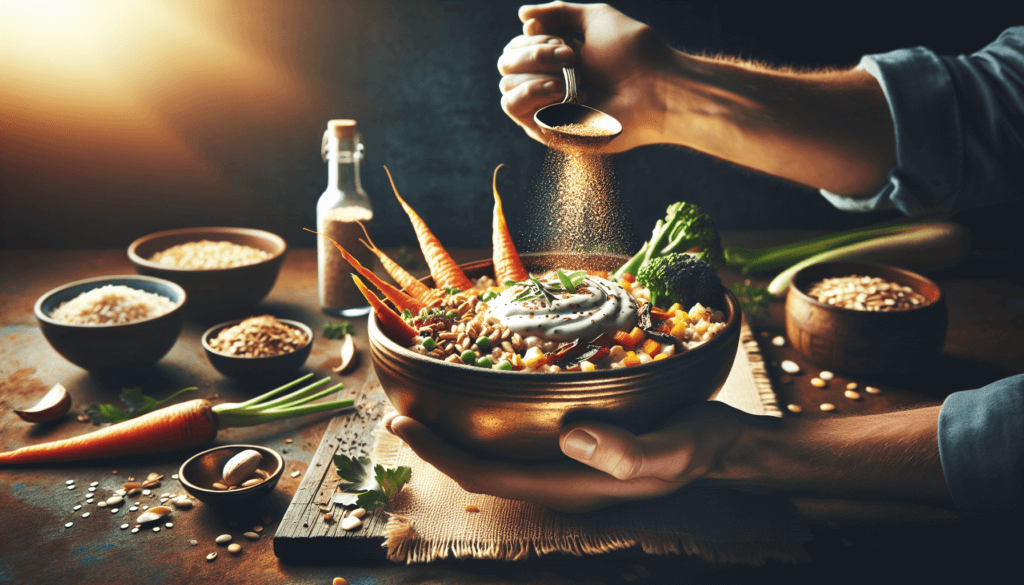Imagine sinking your teeth into a warm, indulgent slice of pizza or savoring a creamy serving of macaroni and cheese, all while knowing that you are enjoying a guilt-free, grain-free comfort food experience. That’s right, grain-free comfort food is here to revolutionize your meals and nourish your body with wholesome, satisfying ingredients. No longer will you have to sacrifice taste for health – this article will introduce you to a world of delicious alternatives that will leave you feeling satisfied and nourished. Get ready to rediscover your favorite comfort foods in a whole new light!
What is Grain-Free Comfort Food?
Grain-free comfort food refers to delicious and satisfying meals that are free of grains, such as wheat, rice, and corn. These dishes are designed to provide the same level of comfort and satisfaction as traditional comfort foods, but without the use of grains. Instead, alternative ingredients are used to create flavorful and nutritious meals that cater to a variety of dietary needs, including gluten-free, low carbohydrate, and paleo or keto-friendly diets.
Benefits of Grain-Free Comfort Food
Gluten-Free: One of the primary benefits of grain-free comfort food is that it is naturally gluten-free. Gluten is a protein found in grains like wheat, barley, and rye, and can cause digestive issues for those with gluten sensitivities or celiac disease. By eliminating grains from comfort food dishes, individuals who need to follow a gluten-free diet can still enjoy delicious meals without any adverse effects.
Low Carbohydrate: Another advantage of grain-free comfort food is that it is generally low in carbohydrates, making it suitable for those following low-carb or ketogenic diets. By replacing grains with alternative ingredients, such as vegetables or nut flours, these dishes offer a satisfying and flavorful alternative to traditional high-carb comfort foods.
Increased Nutrient Density: Grain-free comfort food often incorporates nutrient-dense ingredients, such as vegetables, lean proteins, and healthy fats. By focusing on whole foods and minimizing processed ingredients, these dishes provide a higher concentration of vitamins, minerals, and antioxidants, contributing to a more balanced and nourishing meal.

Popular Grain-Free Comfort Food Dishes
Cauliflower Rice Stir Fry: Cauliflower rice has become a popular alternative to traditional rice, and it serves as the perfect base for a flavorful stir fry. Packed with colorful vegetables, protein, and delicious seasonings, this dish is both satisfying and nutritious.
Zucchini Noodle Carbonara: For pasta lovers, zucchini noodles are a fantastic substitute. When tossed in a creamy carbonara sauce made with eggs, cheese, and bacon or pancetta, zucchini noodles transform into a decadent and grain-free comfort food option.
Sweet Potato Shepherd’s Pie: Traditional shepherd’s pie typically features a mashed potato topping, but by replacing it with a layer of creamy sweet potato mash, this classic dish becomes grain-free. Filled with savory meat and vegetables, it’s a comforting and nourishing meal.
Butternut Squash Mac and Cheese: Creamy and comforting, butternut squash mac and cheese is a healthier twist on the classic favorite. By using pureed butternut squash as the base for the cheese sauce, it provides a rich and velvety texture without the need for grains.
Alternative Grain Ingredients
Almond Flour: Almond flour is a versatile and nutritious alternative to wheat flour. It is made from finely ground blanched almonds, providing a delicate nutty flavor and a moist texture to baked goods.
Coconut Flour: Made from dried coconut meat, coconut flour is a high-fiber and low-carb alternative. It adds a subtle sweetness to recipes and works well in both sweet and savory dishes.
Tapioca Flour: Tapioca flour, also known as tapioca starch, is derived from the cassava root. It has a light and fluffy texture, making it ideal for thickening sauces, puddings, and soups. Tapioca flour is also a great gluten-free baking ingredient.
Cassava Flour: Cassava flour is a grain-free flour made from the starchy tuber of the cassava plant. It has a similar texture to wheat flour and can be used as a one-to-one replacement in many recipes.

Healthy Substitutions for Traditional Ingredients
Replacing Rice with Cauliflower or Broccoli Rice: Cauliflower and broccoli can be transformed into rice-like grains by pulsing them in a food processor. These vegetable rice alternatives provide a similar texture and absorb flavors well, making them excellent substitutes for traditional rice in stir-fries, pilafs, and grain-free sushi.
Replacing Pasta with Zucchini Noodles or Spaghetti Squash: Zucchini noodles, also known as zoodles, can be created using a spiralizer or a julienne peeler. These spiralized veggies mimic the shape and texture of pasta, making them an excellent choice for grain-free pasta dishes. Another alternative is spaghetti squash, which can be roasted and separated into noodle-like strands.
Replacing Bread with Lettuce Wraps or Portobello Mushroom Buns: Lettuce wraps offer a refreshing and low-carb substitution for traditional bread-based sandwiches or tacos. For a heartier option, portobello mushroom caps can be used as buns for burgers or sandwiches, providing a savory and satisfying alternative.
Grain-Free Baking
Basic Grain-Free Flour Blend: Creating a grain-free flour blend is a key component of successful grain-free baking. A basic blend could consist of equal parts almond flour, coconut flour, and tapioca flour. This mixture provides a balanced result, combining the moisture and richness of almond flour, the structure-building properties of coconut flour, and the lightness of tapioca flour.
Grain-Free Chocolate Chip Cookies: Grain-free chocolate chip cookies can be achieved by using a combination of almond flour, coconut flour, and a natural sweetener like honey or maple syrup. Mixing in dark chocolate chips or chunks adds extra indulgence without the grains.
Grain-Free Banana Bread: A delicious alternative to traditional banana bread can be made with almond flour and mashed ripe bananas. The nutty flavor of almond flour complements the sweetness of the bananas, creating a moist and flavorful loaf that satisfies without the use of grains.
Spices and Seasonings for Flavorful Grain-Free Dishes
Turmeric: Turmeric offers a warm and earthy flavor, along with a vibrant golden color. It is known for its anti-inflammatory properties, adding both health benefits and flavor to grain-free dishes.
Cumin: Cumin is a versatile spice that adds a distinctive warm and slightly smoky flavor to a wide range of grain-free dishes. It pairs well with proteins, vegetables, and legumes, adding depth and complexity to the overall flavor profile.
Garlic Powder: Garlic powder is a convenient and flavorful ingredient that enhances the taste of grain-free dishes without the need for fresh garlic. It blends well with a variety of spices and herbs, providing a savory and aromatic element to comfort food recipes.
Smoked Paprika: Smoked paprika lends a rich and slightly smoky flavor to grain-free dishes. It can be used to add depth to soups, stews, or roasted vegetables, providing a unique and complex taste to the final dish.
Tips for Making Grain-Free Comfort Food
Experimenting with different grain-free flours: The world of grain-free flours is vast and varied, so don’t be afraid to explore and experiment with different options. Each flour brings its own unique taste and texture to recipes, so it’s worth trying a few to find your favorites.
Adding flavor with spices and herbs: Since grain-free comfort food relies on alternative ingredients for flavor, don’t skimp on herbs and spices. With a rich blend of seasonings, these dishes can be transformed into flavorful and satisfying meals that rival their grain-filled counterparts.
Using high-quality ingredients: To ensure the best taste and quality in your grain-free comfort food, opt for high-quality ingredients. Choose organic produce, ethically raised meats, and natural sweeteners to maximize both flavor and nutritional value.
Grain-Free Comfort Food for Special Diets
Paleo-Friendly Comfort Food: Grain-free comfort food aligns well with the principles of the paleo diet, which emphasizes whole, unprocessed foods. By eliminating grains, these dishes cater to those following a paleo lifestyle while providing comfort and satisfaction.
Keto-Friendly Comfort Food: The low-carbohydrate nature of grain-free comfort food makes it suitable for individuals following a ketogenic diet. These meals promote ketosis by limiting carbohydrate intake while providing the same level of comfort and satisfaction as traditional comfort foods.
Vegetarian and Vegan Comfort Food: Grain-free comfort food can also cater to vegetarian and vegan diets. By incorporating plant-based alternatives and protein sources, such as legumes, tofu, or tempeh, these dishes offer a variety of options for those who choose to avoid meat or animal products.
Conclusion
Grain-free comfort food offers a delicious and nutritious alternative to traditional comfort foods, while catering to a variety of dietary needs. By embracing alternative grain ingredients, healthy substitutions, and flavorful spices and seasonings, grain-free dishes provide both comfort and health benefits. Whether you’re following a gluten-free, low-carb, paleo, or keto diet, or simply looking for a nutritious and flavorful meal, grain-free comfort food is a versatile and satisfying choice. So why not indulge in the goodness of grain-free dishes and treat yourself to a comforting culinary experience that is sure to please both your taste buds and your body?


